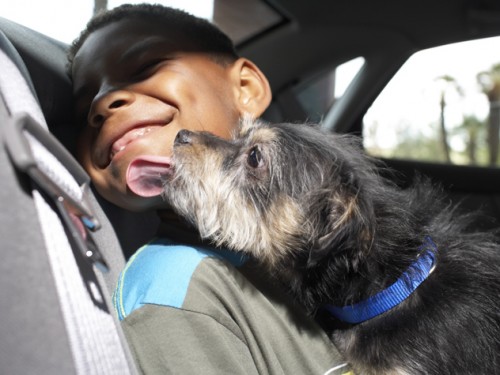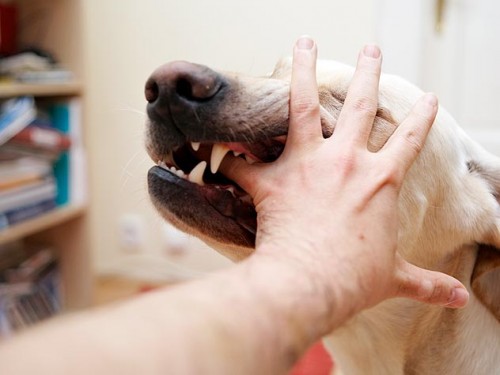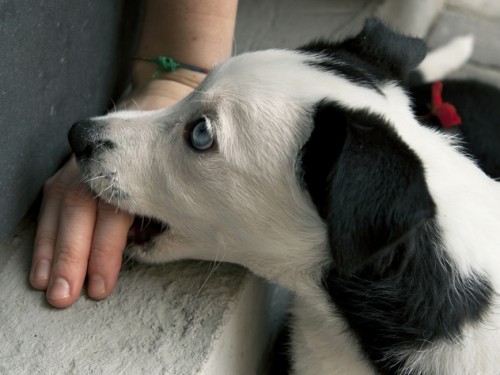Barking at Mail Carriers
I’ve never believed that dogs bark at mail carriers because they wear uniforms. I’ve yet to see a dog get upset over a marine, or a Girl Scout – so why mail carriers? The reason, I believe, is that dogs have no idea what a mail carrier is up to. A carrier drops mail into a box outside the front door. Since dogs seldom get mail, all they know is that this person brazenly walks up to their door, jiggles a box outside, and leaves without even a “Hey, boy, how ya’ doin’ today?”

The ruckus begins the instant our carrier’s foot touches our block. All the dogs up the street begin to bark. As the carrier approaches our house, PeaJay begins with low, intermittent snarls. When the carrier is two doors away, the snarls are replaced with a staccato of barks that crack across the living room. Each series of barks ends with a howl that tapers off as his lungs collapse like spent balloons.
“Quiet,” I yell. “Quiet!”
For a moment he heeds me, just long enough to give me this odd look that I interpret loosely as, “Please, Master – fish gotta swim, birds gotta fly…”
By the time the carrier reaches my door, PeaJay’s state is frenzied. He wants to charge the window, but he’d have to leap on the couch to do that. But he’s not allowed on furniture, so he hurls his expletives at the door. When the carrier is a few doors past us, PeaJay calms down somewhat, pacing the living room as he grumbles and grunts, “…and you better keep on movin’!”
The ritual ends when the barking outside diminishes, signifying that the carrier has turned the corner. PeaJay, with a sense of accomplishment, stiff-legs it to the middle of the living room, executes a few turns in place and plops down heavily-asleep in a fraction of a second.
A variation of this scenario occurs wherever dogs cross paths with ‘appointed rounds.’ What really ticks off a dog is that a mail carrier never allows an opportunity for even one quick sniff of a pant leg. This, to a dog, is the height of bad manners. For to a canine, permitting a cursory sniff is akin to being handed a diary. The floating molecules snatched by his nose tell him if you’re friend or foe. A more thorough olfactory inspection reveals the species and gender of the pets you have, plus megabytes of other data that our inept proboscises can’t begin to fathom.
I’ve toyed with the idea of testing my theory by opening the door and introducing my dog to the carrier. I feel that after a few sniffs, PeaJay would wonder why he’s treated mail carriers with such contempt for all these years. But I hesitate…I fear that the intensity of the moment might cause PeaJay to skip the sniffing protocol, placing my theory, and the carrier, in an embarrassing position. With this in mind, I let sleeping dogs lie.
Why Does My Dog Lick Constantly?
Q: I have a question about dog anxiety. My Rottweiler, Bailey, licks compulsively. It seems like he just can’t relax. Is there something I can do to help him chill out?
I have been considering taking him to the vet, but don’t want him to have to take a sedative. Any suggestions?
A: I would definitely take your Rottweiler to the vet. First, you want to rule out licking because of allergies or injury.

Some repetitive behaviors are made worse because the dog uses them as attention-seeking behaviors. Some dogs find negative attention to be more rewarding than being ignored.
However, before we consider the licking to be attention-seeking behavior, you want to rule out the other reasons first.
Why Dogs Bite
Every year in the United States, 800,000 dog bites are severe enough to need medical treatment; 17 are fatal. Fifty percent of all American children are bitten by a dog before the age of 13. Literally every dog has the potential to bite. Luckily for us, most don’t. Understanding what causes this phenomenon might help you to avoid becoming next year’s dog-bite statistic. The following are six common reasons why dogs bite.

In cases of dogs who bite due to dominance aggression, members of the dog’s human family are most often the victims. Innocently attempt to move a dog off the bed to change the linens; push down on his rump to ensure compliance with a sit command; step over a dog who’s resting inconveniently in the doorway and the dog erupts in a “you’d better not do that” vocal warning, followed by a bite.
In each situation, the dog believes that he is in charge – that his humans have not earned the status to tell him what to do. Dominance aggression is most commonly – but not exclusively – seen in unneutered males and in confident breed types, such as rottweilers, chow chows, Lhasa apsos, English springer spaniels, Old English sheepdogs and Rhodesian ridgebacks, to name but a few. Obedience training as early as possible can abate a dog’s tendency toward dominance aggression, but dogs who are naturally and intractably dominant aggressive must be closely monitored and kept clear of situations known to trigger the negative behavior. Hollywood trainer Shelby Marlo, author of “Shelby Marlo’s New Art of Dog Training: Balancing Love and Discipline,” states, “Management is underrated. There is nothing wrong with knowing the dog’s limitations and living within those boundaries.”
Protection of valuables
The protectiveness some people seek when acquiring a dog can prove to be a liability. Some dogs believe the only way to protect their valuables is through an act of aggression. A dog’s list of valuables may include food, toys, territory (a house or a car) or even their human family members. Dogs have been known to “protect” one family member from another, driving crying children away from their mothers or chasing amorous husbands out of bedrooms.
The protection of territory is most often seen in males of guarding/herding breeds, such as German shepherds and rottweilers, while certain cocker spaniels and Labrador retrievers – females more often than males – put on ferocious displays over toys and chewies resulting in punishing bites to hands and faces.
Again, early training and/or lifelong management are the only solutions.
Fear aggression
The fear aggression response is most often directed toward strangers. Veterinarians learn early in their careers: when in doubt, muzzle. Like people, dogs are naturally fearful of unfamiliar and potentially threatening situations. A dog raised in a quiet adult household will be distraught by noisy, fast-moving youngsters. The dog may bark and lunge to drive them away and deliver a stinging nip to children who do not heed the warning.
There is no particular breed or gender predilection for fear aggression, but these biters commonly lack early socialization to a wide variety of people and experiences. ASPCA Vice President of Behavioral Medicine, Amy Marder, V.M.D., states that “with a dedicated owner and a responsive dog, fear aggression can be greatly improved.”
Maternal aggression
The first two to three weeks after a female dog gives birth, her puppies rely on her for all they need to survive: warmth, nutrition, stimulation to prompt elimination and protection. Even the most outgoing, well-trained dog may show signs of maternal aggression if she feels her newborns are at risk. No training is indicated here, rather an awareness of the new mother’s innate need for a safe space. By limiting visitors to the whelping box to one to two adult family members during those first couple of weeks, the new mother will stay relaxed and focused on the job at hand. There will be plenty of time for socialization once the pups’ eyes are open and they are toddling about under their own steam.
Redirected aggression
An attempt to break up a dog fight is the most common scenario for this category of biting. Two canine opponents are barking, posturing and biting at each other when all of a sudden hands reach in and grab at collars, tails and hind legs. The adrenaline-pumped dogs blindly whip around and land oral blows to body parts of the interrupters.
Fights are best broken up by loud noises or strong blasts of water when available. However, sometimes that is not enough. If you must lay hands on fighting dogs, stay as far away from the mouth as possible and move swiftly and decisively.
Pain-induced aggression
While pain-sensitive breeds like Chihuahuas are common perpetrators, any dog may bite if hurting, depending on the degree of pain. An otherwise gentle dog will bite a beloved owner’s hand trying to soothe, bandage or examine wounds. Like us, each dog has a unique pain threshold and tolerance. A sweet floppy-eared dog suffering from otitis externa may bite on getting his ears tousled; a dog with hip dysplasia may turn on a handler pressing down on his hips to enforce the sit command.
Of course, any dog can be provoked to bite by overly zealous physical disciplining.
Pestered beyond limits
There are dog biting incidents that don’t fit into the aforementioned categories. Perhaps a new category is required, called “Pestered Beyond Limits.” Bites in this category are often prompted by children (or adults) who simply don’t understand that even a dog has limits. Hug a sleeping dog, blow puffs of air in his face, put a rubber banded knee-sox on his nose to turn him into an “elephant dog,” ride him like a pony, stuff him inside a pillowcase just to see if he’ll fit, poke, prod, tickle him, and sooner or later, the dog will say “NO!” the only way he knows how – through a bite.
There are three keys to bite prevention: learn to understand canine behavior, take the time to socialize and train all dogs – the younger the better – and teach children to respect all dogs, starting with their furry buddies at home. With this accomplished, there is no telling how low bite statistics can go.
If you are approached by a menacing dog:
do not attempt to run
stay quiet, and remember to breathe
be still, with arms at sides or folded over chest with hands in fists
avoid eye contact
The Dog And The Meter Reader
In 1997, the safety division of Con Edison, New York City’s utility supplier, set a goal of a 20 percent reduction in worker accidents for 1998. By October, they were on target in every category except dog bites, having surpassed 1997′s 24 bites in the third quarter. Bernard Duffy, project specialist for Environmental Health and Safety, and The ASPCA worked together to create a mandatory half-hour program for all Con Edison customer field representatives. The program aimed at preventing utility worker/dog interactions and minimizing injury should an interaction take place.
Field worker Edwin Gomez credits this ASPCA Bite Prevention Workshop for saving him from a serious injury. Upon arriving at a customer’s home to read the electric meter, Edwin Gomez followed Con Edison’s company policy, and requested that the family dog be secured in another room. That done, Gomez went to work. Before he finished, however, the dog escaped from isolation, flew at Gomez and grabbed his arm.
Fortunately, Gomez remembered the advice he learned at the Bite Prevention Workshop: “If bitten, push into the dog’s mouth instead of pulling away.” And push he did, using his flashlight against his arm for added pressure. Sensing he was no longer in control of the bite, the dog let go and ran away, leaving Gomez shaken but with no more than a couple of small punctures in his sleeve and a sore arm from the tetanus shot he got “just in case.” At last count, dog bite incidents were reduced by more than 50 percent from last year.
How to Stop Dog Mouthing

What is Mouthing?
“Mouthing is when a dog puts his teeth and mouth over a person’s skin while using little or no pressure from his jaw, says dog trainer and expert Mikkel Becker onVetstreet.com. “It’s not to be mistaken for aggressive biting, which is done out of fear or frustration.”
While mouthing may not be an aggressive behavior, it’s still frustrating and your dog could unintentionally hurt or scare someone, or the behavior could escalate into a bite.
Certified pet behaviorist and author Amy Shojai suggests using a two-pronged approach to curbing your dog’s mouthing behavior, starting with teaching “bite inhibition.”
Bite Inhibition
“Bite inhibition is a dog’s ability to control the force of nipping and mouthing,” according to Vetstreet.com. “A dog who hasn’t learned bite inhibition doesn’t recognize the sensitivity of human skin, so the dog nips and mouths too hard, even when playing.”
Puppies and young dogs typically learn bite inhibition during play with other dogs, according to author and dog expert Jennifer Bridell. When dogs play, they frequently use their mouths. If one dog bites too hard, the bite victim yelps and stops playing. This usually gives the biting dog pause. This is how dogs learn to control the force of their bites. Biting too hard means play time stops, and no one wants that to happen.
Amy Shojai recommends people use a similar approach when trying to teach their dog bite inhibition . The basic idea is to reward the desired behavior and redirect or ignore the unwanted behavior. This training will take patience and time, and the best results might come with working with a Certified Professional Dog Trainer or behaviorist.
Teaching Bite Inhibition
People can use strategies similar to puppy play to teach their dogs bite inhibition:
Allow your dog to mouth you during playtime.
Continue playtime until he bites hard.
When he bites hard, let out a puppy-style yelp, and then promptly stop “playing” by letting your hand go limp.
This should cause your dog to pause. When he does, praise him enthusiastically and resume play as normal.
Repeating this over and over should help him get the message. If it doesn’t, you can introduce brief time outs by stopping play all together and walking away after you yelp. After 20 seconds or so of calm behavior from your cutie, return to him and play with him again. This helps teach him that painful play is “bad,” and gentle play is “good.” Gentle play buys him more playtime, while painful play ends it. No fun there.
Continue this sequence. You should notice your dog’s bites progressively getting gentler and gentler – until they have little to no pressure.
After you’ve helped your dog learn to be gentle with his mouth, it’s time to teach him not to mouth people at all.
Teach Your Dog to Stop Mouthing
The experts at Vetstreet.com recommend the following techniques for getting your dog to stop mouthing you and other people:
Substitute a toy or chew bone when your dog mouths.
When you stroke your dog, offer him tasty treats from your other hand to discourage mouthing you as you pet him.
Encourage non-tactile games like tug-of-war instead of rough play , such as wrestling.
Help your dog learn to manage his impulses through activities such as “Leave it” and “Sit.”
If your dog likes to “ambush” your feet or ankles, stop moving as soon as he does this. Then, distract him with a toy. When he grabs the toy, continue moving.
Provide your dog with regular playtime sessions alongside other well-behaved canines. This can tire him out and make him less interested in strenuous play (and therefore mouthing behaviors) with you.
Rescue Dog Behavior Problems
Trust and Anxiety Issues
There are some cases where rescue dogs immediately warm up to their new owners, giving lots of kisses and love. But many pups who are rescued have moderate to severe trust and anxiety issues, and it’s no wonder. Some of these dogs have been tossed out in the cold, others dealt with long-term abuse and some lived in horrible conditions, surrounded by their own waste. They’ve been dealt a pretty bad hand in life, and they haven’t had a good reason to trust anyone or anything. They’re worried about how their new owners will treat them and what they will encounter. How they act depends largely on their past experiences. If a pup suffered abuse at the hand of a man, she may be more trusting of women and flee to her secure spot if a guy comes within five feet of her. And sometimes the dog may not trust anyone, shying away from all interaction.
Irrational Fears
A lot of times, rescue dogs haven’t experienced anything aside from neglect. The first time you brighten one’s life and bring her home, she’s seeing and hearing things that can be really scary at first. You would think every dog loves squeakers, or at least tolerates them, but dogs who’ve never had toys before may freak out when they hear that first squeak. On the flip side, there are certain stimuli that a rescue dog may have associated with negative experiences. A classic example is a newspaper. It’s harmless in your hand, but your new furry friend may have been smacked with newspapers before, so when you lift one up, she cowers.
Aggression
It’s not uncommon to bring your little rescue girl home and hear a deep growl when you walk past her food bowl, struggle to keep her from lunging and sinking her teeth into another dog or otherwise witness aggression. Something usually triggers the aggressive episodes. If she grew up in a hoarding situation, she may have had to compete for food, which would explain possession aggression. If she was neglected, she may act aggressively out of fear. Even though you removed her from her awful situation, her aggressive tendencies still remain. She doesn’t know that another dog won’t steal her food or that she doesn’t need to fight for her life upon encountering another canine.
Bad Habits
Some rescue dogs may not have any trust issues, few irrational fears and not an ounce of aggression, but you can almost guarantee they’ll all have bad habits. The first few weeks, months or even years with your new rescue will probably result in you trying to break some of those nasty habits. She may jump on people, rip up the couch, destroy things when you leave, relieve herself on your floor and may act like she’s deaf when you try to stop her.
Fixing All the Issues
Remember that no matter what problems your rescue comes with, she can be trained and counterconditioned so that all those bad habits, aggressive tendencies, fears and trust issues will go by the wayside. Showing her lots of love and teaching her basic obedience with positive reinforcement will help her warm up to you and mold her into a better behaved canine. As for deep-seated fears, aggression and severe behavior problems, talk to a certified dog trainer, especially if she’s aggressive.
How to Tell If Your Pregnant Dog Is Having Problems Giving Birth?
Discharge
Your pregnant dog might be experiencing birthing difficulties if you notice any conspicuous genital discharge prior to any of the youngsters emerging. If her body is giving off a substance that is black, green or brown, contact a veterinarian immediately. Extended vaginal bleeding during birthing also points to a problem, so do the same in that situation, too.
Lack of Moving Forward
A lack of development and moving forward in labor also usually signifies a problem. If a mama-to-be has been trying hard to birth her puppies for around 40 minutes with no sign of any of them, there could be an issue. Excessively long amounts of time between puppies also often indicates a problem. If her previous newborn came out between two and three hours ago and she’s still making a serious effort to get the rest out, immediately contact your veterinarian.
Relaxation Time
If your dog decides to take a break between birthing her puppies, pay close attention to the amount of time she spends taking it easy. If you observe that she’s been relaxing for more than four hours, it’s time to get a helping hand and let your veterinarian know what’s going on. If it’s clear to you that your dog is suffering with discomfort in any way, don’t ignore it.
Unusual Signs
Any unusual physical signs also can denote whelping issues. If the pregnant doggie is breathing with her mouth hanging open, there could be a problem. Shivering is another key sign of a problem. Be alert to any and all indications of malaise.
Dystocia
Any female dog can undergo complications during pregnancy, whether younger or older, small breed or large breed. However, canines of certain breeds are often more susceptible to dystocia and its associated dilemmas. These breeds include shih tzus, Boston terriers and French bulldogs. Brachycephalic pooches such as these are particularly vulnerable. Brachycephalic dogs are those with somewhat wide and “flattened”-looking visages.





